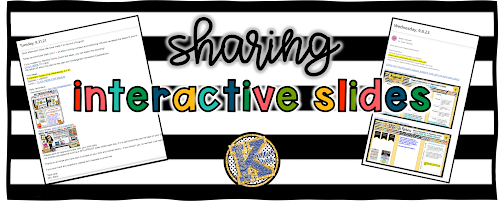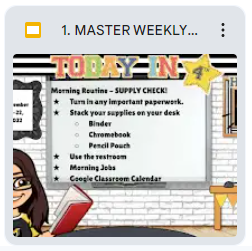26.9.23
Interactive Slides Backgrounds
22.9.23
Sharing Interactive Slides
Hey, have you ever thought about making your own interactive slide decks? Maybe the thought has you feeling overwhelmed because you don't understand the technology, or there are just so many options you don't even know where to begin. Well, don't worry, I've got you. I am working on an interactive slides masterclass, a one-time course you can take at your own pace to learn all the tips and tricks I know for creating interactive slide decks that you and your students will love. We'll talk about how to create interactive slides like my calendars and literacy reviews, and also daily focus slides that you can use in your classroom every day of the school year. We'll even talk about how you can come up with your own ideas to create slides that you can sell yourself. I mean, if we're going to do all this work for our own classrooms, why not help other teachers and make a little passive income on the side, right? CLICK HERE to learn more about 21st Century K's Interactive Slides Masterclass!
6.9.23
Daily Focus Slides in 21st Century Elementary
I still say PowerPoint is superior and there are many things PowerPoint can do that Google slides cannot just yet, but Google slides is a pretty close second. I started creating daily slides that I used with my online lessons, both to share over Zoom and also to send to families so that they could access the teaching content as well on their own time as they worked through assignments. The first slide in the slide deck would have all the expectations for the day, the things that they needed to have ready for our live lesson. It would have the cover of the book we were going to read and, of course, my cute Bitmoji, who was prepared for whatever content or season or holiday was around the corner, and I would post this at the beginning of each of my live lessons and from there I had other slides that I would go to that were made to look like classrooms for each subject area and that would sort of signify in a visual way that we were switching to new content, and also was a place for me to show things like anchor charts and vocabulary word definitions, as well as pictures of the worksheets that they needed to pull from their folder in order to work with me when I was live online. In addition, I could put pictures of completed worksheets so that when parents went back to that slide deck later, they would see what the answers to the questions were in order to better help their children.
It was really a pretty cool thing, if I do say so myself, and when I went back to teaching kindergarten in person, I continued to use my slide deck resources. I mean, I had spent a lot of time on those and I had also done tons of research and found all kinds of slides that were made into libraries about different thematic contents or author libraries or activities or science videos. In fact, there are still more, or there are still bitmoji classroom groups on Facebook that are active today. If you join them, lots of people share free resources they've created. You just click it, copy it to your Google Drive and then you can access the slides to add them to your own slide decks and many of them are made to where you can edit them and use them as you see fit.
So because I had created this vast collection of slides, I thought well, why can't I use this to help me in the in-person classroom? I posted my daily or weekly once I was in person morning slide that had the letter we were studying the book we were reading, the lunch choice for the day and all kinds of other things listed along with my cute bitmoji, and this would be posted when the students would come in the classroom each morning. Behind that, I would have linked up a slide for each subject area and also slides with those cool libraries and videos that I talked about before. Then I could project this and talk a little between the slides and access any of the content that I needed at any given time during the school day. It became really, really useful in the classroom.
So when I moved to fourth grade, I continued. I definitely still have my first slide and I still use my bitmoji, even though it's kind of cheesy, and I have a slide for each day of the week, but it looks a little different For the big kids. I have listed the activities that we're going to do for the day. I have my ICANN statements and my guided questions, guiding questions, guided guided questions. Easy for me to say Sorry, my guiding questions posted, but I also link up whatever texts we're going to be reading. I have a 10 minute timer that comes in really handy for journal entries and other things like that. On my morning slide for my homeroom I link to our school news and so I can get that with a click and show it to my students and include the lunch choices and just all that good stuff. It really makes the transition to reading class easy because it's popped up on the board and there's no guessing what will happen in class that day. Students can come in, look at it and know what the expectation is going to be. But organizing my day is not where these daily focus slides end.
I really, really liked when my online families back during the pandemic could access those slides and use them at home. So when I taught kindergarten in person after the pandemic, I would link my slide deck in my daily emails and it became really great for families to click and go in. They could review concepts and contents, they could watch video lessons, their students could click and read some of their digital guided reading books to their families and it was a great way for families to make connections with what we were learning in school. I continue to do the same thing in fourth grade, sharing my slide deck with families every week. It's wonderful for the older kids because if a student is absent or gone on a trip, they are able to access each daily plan and also access the text that we're reading, because I try to include a YouTube link for each book that I'm going to be reading, which is super handy when I don't have a copy of the book or I need to speak with someone, but the class needs to keep going forward or I lose my voice and don't feel well and feel like reading that day.
It's nice to have all of those digital links right there handy for myself and for my students and their families, but I also share these slide decks with my collaborative teachers, with substitute teachers and with my administrator. There's no question what is going on in my classroom and I have one place for my co-teachers, collab teachers and anyone else who comes in the classroom to access and view and help students with what we're working on. It's really become an important part of my lesson planning. In fact, because I love Google slides so much, now I even do my lesson plans on Google slide and each week I link to that slide deck. It's so wonderful when we can create systems to help ourselves in the classroom that we can use over and over again, and that's why, after taking the time to create these slide decks last year, I'm reaping the benefits my second year and fourth grade when I go to that file, pull up the slide deck for the week, check the links, make a few tweaks, change the day and I am ready to go each Monday morning. The time saved is well worth the work that I put in on the front end creating them the first time. Aside from just keeping me on track while I'm teaching, my daily focused slides help my students stay focused on the lesson when know their expectations, and they help my families be able to connect to our education my co-teachers and collab teachers to access what we're doing each day, my administrators, if they want to keep tabs on my fourth grade classroom, and even my substitute, when they come in, has access to everything that we're doing that day. It has been a huge help in my classroom and if you don't use daily focused slides, I highly encourage you to start. Start with one, see how you like it, and I guarantee you'll be adding to them and saving them year after year, just like me. Thanks for listening.
Hey, have you ever thought about making your own interactive slide decks? Maybe the thought has you feeling overwhelmed because you don't understand the technology, or there are just so many options you don't even know where to begin. Well, don't worry, I've got you. I am working on an interactive slides masterclass, a one-time course you can take at your own pace to learn all the tips and tricks I know for creating interactive slide decks that you and your students will love. We'll talk about how to create interactive slides like my calendars and literacy reviews, and also daily focus slides that you can use in your classroom every day of the school year. We'll even talk about how you can come up with your own ideas to create slides that you can sell yourself. I mean, if we're going to do all this work for our own classrooms, why not help other teachers and make a little passive income on the side, right? CLICK HERE to learn more about 21st Century K's Interactive Slides Masterclass!










